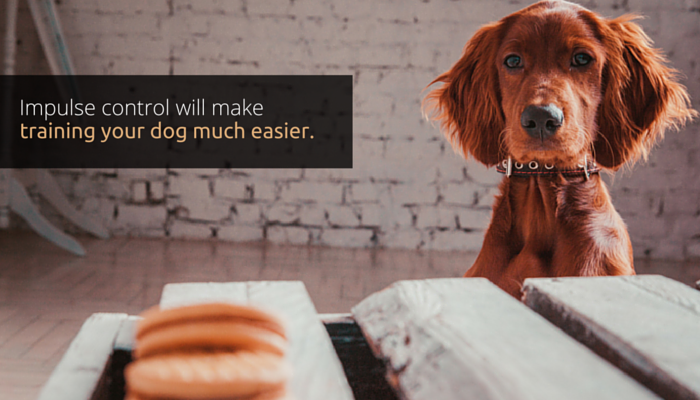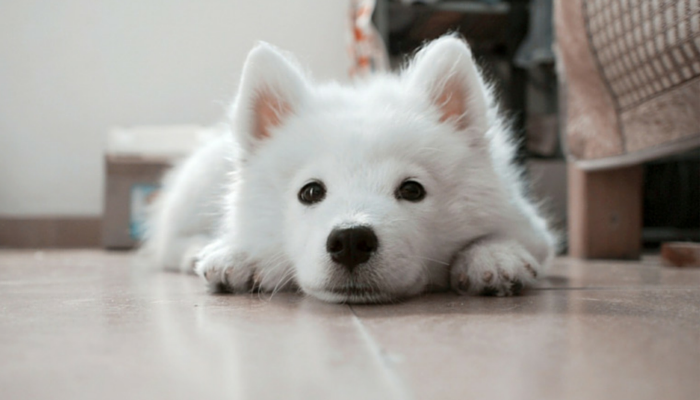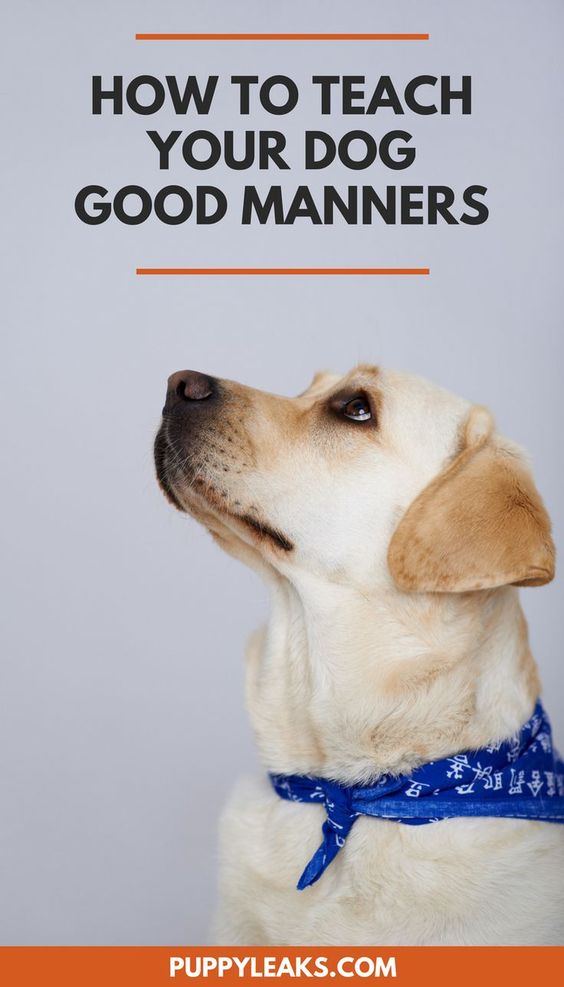5 Ways to Increase Your Dogs Impulse Control
How attentive is your dog? Whether you realize it or not you’re probably already the center of his universe — at least until a squirrel runs by.
Trying to keep your dog’s attention when a squirrel runs by is something all of us have struggled with, but luckily working on your dog’s attention span and focus (or lack thereof) is something that can always be improved upon. It’s called increasing your dog’s impulse control, and it’s an important part of teaching your dog good manners.
And you’ll notice that once you start working on your dog’s impulse control everything will start to get a little easier, from teaching them new tricks to going for your daily walk. Teaching your dog good impulse control is a big part of having a well behaved dog. Here’s 5 ways to increase your dog’s impulse control.
What is Impulse Control in Dogs?
Impulse control is the ability to resist urges and impulses. If you’ve ever watched a dog doing agility and wondered how on earth they’re able to concentrate and run through all those obstacles while there’s a bunch of barking dogs on the sidelines it’s because they have excellent impulse control.
On the other hand a lack of impulse control leads to dogs doing things without thinking about the consequences. If your dog rushes through the front door anytime you open it they’re exhibiting a lack of impulse control. The same goes if your dog jumps all over your guests. We tend to call dogs that have poor impulse control pushy and impatient, but in most cases it’s just due to a lack of training.
Dogs aren’t born with what we consider good manners, just like nearly everything else they have to be taught. And like any other behavior you can improve your dogs impulse control through training & consistency.
But just like we teach our toddlers, who share a similar weakness for giving in to temptations, we can also teach Rex and Sadie that patience, calm and polite behaviors are more effective in getting what they want than jumping, pushing, pawing or barking. – Impulse Control: The 6 Keys to Teaching Dogs Calm & Polite Behavior
Dogs Need to Learn Impulse Control
If you’re raising a puppy or teenage dog you already know how challenging it can be. Puppies aren’t exactly known for their amazing attention spans. And when they hit adolescence it’s like they suddenly wake up one day and forgot everything — they stop listening to us and start acting on their own impulses.
Luckily practicing impulse control with your dog can help. And trust me when I say this — great focus & impulse control will make all of your training so much easier.
Have you seen those agility trials where those dogs are constantly focused on their handler? I used to watch those shows and wonder in the world they were able to get that sort of focus from their dogs.
Turns out any of us can get that sort of attention — it just takes consistency and practice.
So you want to teach your dog better manners? It all starts with impulse control. Here’s 5 ways to increase your dogs impulse control that you can do today.
Is Your Dog Easily Distracted?
When it’s time to train your dog do you find yourself competing for his attention? Does your dog get easily distracted by other dogs or people? Does he go off and follow his nose rather than listen to you? Is he get overly excited by any noise or movement?
If you answered yes to any of the above working on impulse control work will benefit both you and your dog. Having your dog focused and attentive to your commands will make all of your future training sessions easier. It all starts with a good foundation built on trust, focus, and lots of impulse control work
Start With Realistic Goals For Your Dog
Imagine yourself at the dog park with Fido on a nice summer day. When you open that gate I bet your dog is interested in everything but you.
For most of us dog owners having great focus while surrounded by such chaos doesn’t seem obtainable, it actually seems impossible. It’s something only advanced dog owners do; they’ve even got dog training classes specifically for that purpose.
While it’s certainly not easy it is obtainable. If you start with realistic goals and build on your success you can have an attentive dog in those sorts of situations as well. But like many other great things in life it’s not quick, it’s not easy, and it takes a lot of hard work.
Since my own dog is reactive a trip to the dog park isn’t going to happen, I needed something more realistic for the both of us.

How Impulse Control Makes Dog Training Easier
Once your dog has great focus & impulse control all of your training goals will be much easier to accomplish. Many of my dog’s problems had to do with our daily dog walk, so instead of just focusing on making the walking easier blindly I decided to build up her impulse control & focus first. It made everything so much easier.
Laika used to be extremely leash reactive – anytime we encountered another dog, cat, horse, or creature on a walk she’d become a trembling, howling, pulling mess. Luckily it never ended up with any serious consequences, but it was always a possibility, and that behavior was completely unacceptable. It’s not only completely embarrassing, it’s a major liability.
While she’s not perfect, and I still make my fair share mistakes, we’re a much better pair these days. 99% of our walks are completely uneventful, even when we have to walk by a trio of horses or a pair of loose dogs. That 1% is reserved for the neighborhood cat Danny that likes to stalk walk along with us from time to time.
That was my biggest goal with Laika – keeping her calm on walks. And having her already focused on me as we set out the door for our walk made conquering those trouble spots easier.
Your goal might be teaching your dog 100 new tricks, learning some nose work, or maybe even the ultimate test – keeping your dog calm at the dog park.
Whatever your training goal is it’ll be much easier if you’ve got your dog’s full attention; and luckily increasing your dogs focus and impulse control isn’t very difficult. Once you’ve got the the basics mastered you can move on to more distracting locations.
Remember that impulse control in one situation will affect arousal and control in another. So that if our dog goes bonkers over squirrels and over tennis balls, say please by sitting in order to play fetch is important for getting him to behave well around squirrels too. – Sophia Yin
Should You Use a Clicker?
Ive found training my dog much easier since I started clicker training. When relying on treats or praise it’s easy to miss the right “Aha!” moment, and I’ve also found that using different rewards yields different results.
To keep things consistent when working on obedience or basic commands I prefer using a clicker. When I’ve got that clicker in my hand it’s always the same exact cue every single time, and it’s easy to make sure I’m marking the exact moment to offer praise.
Not everyone loves clicker training and that’s perfectly fine; dogs respond well to any kind of positive reinforcement. As long as it’s given consistently and something yummy or fun your dog will be willing to keep at it.
5 Steps to Increase Your Dogs Impulse Control
When it comes to teaching your dog good manners an impulse control remember to start small, set realistic goals, and build on your prior successes. It all sounds so simple — but being consistent is where a lot of us fail.
The general goal of all dog training is to teach our pets impulse control. We want them to resist their immediate desires and, instead, comply with our cues or commands. Accomplishing this allows us to keep our pets under control, ensuring their safety and comfort, as well as the safety and comfort of others. – APSCA
When I first got Laika I was pretty lax with a lot of behaviors. She’d push my hands around with her nose or paws when I had treats in my hand, and she had a really bad habit of jumping up on everyone she met. I’d try redirecting her with toys, vocal commands, and pretty much everything under the sun. None of it was working — she was already so excited by the time I’d try to intervene.
Offering her more toys when she’s already excited? Yelling while jumping up? These were just adding to the chaos and confusion. I wasn’t doing anything consistently; if something didn’t work the first time I’d try something else.
Once I started working on building up her focus and teaching her some impulse control things went much smoother. When a dog begins to automatically look to you for his next cue you can only imagine how much easier things get. Once your dog trusts that you are in control, and that you can help them make the right decision they’ll start looking to you for all the answers.
You can try one, two, or all of these suggestions to increase your dogs focus and impulse control. They’ve all worked well for us; I’m glad to say while Laika might not be perfect (and neither am I) she’s the closest thing to perfection I could ask for in a companion.
Once I took the extra time to work on the basics we developed a much better relationship. Yelling out random commands wasn’t working, and neither was just saying “no” to everything. I had to learn how to communicate with her, and once I did all training became so much easier.
Does your dog need a little help with manners? Here’s 5 steps to increase your dog’s impulse control.
1. Start By Teaching Your Dog to Look at You
The first step in increasing your dogs impulse control is to have them offer you their focus willingly. With your clicker and yummy treat in hand make some sort of noise to get your dogs attention. As soon as he looks at your click and drop a treat for him.
After he’s had that first treat he’ll make his next choice — either to look back up at you, or to explore everything else around him. Once he decides to look back up at you click and reward again — don’t be afraid to show him how proud you are with lots of praise.
To keep it simple I like to use “look at me” as my verbal cue to my dog. It lets her know that paying attention to me will be rewarded. What you’re looking for is your dogs willingness to stop, look at you, and wait patiently before proceeding. When you build on this behavior your dog is not only learning to focus more on you because you’re the bearer or all good and exiting things – you’re also teaching him impulse control.
Gradually increase the amount of time your dog has to look at you for his reward. If he gets pushy or jumps up to get more treats ignore him. Only click when he’s calmly looking up at you. Eventually your dog should be able to sit calmly looking up at you for 5-10 seconds. Keep these training sessions short and sweet (3-5 minutes each session). Just like many of us our dogs get bored when asked to do the same thing for extended periods of time.
2. Have Your Dog Wait for a Highly Prized Treat
Grab a big piece of ham or some other highly valued treat (or toy) and repeat the first step – waiting for a calm look. If your dog is anything like Laika this will be quite challenging. She would nudge, push, and try to claw her way through my hand just to get one scrap of ham.
We had to go back to rewarding some really quick 1 or 2 second looks before we could proceed further. Eventually Laika got it and I was able to get her attention for 10 seconds while holding the ultimate treat – a fistful of sugar snap peas.
3. Play the Open Hand Game & Teach “Leave It”
While sitting down or leaning over place some treats in your hand and leave it open for your dog to see. If your dog goes to grab the treats close your hand – only open it again once he’s sat back down or backed off. Keep your hand open at all times unless your dog goes to snatch the treats out of it.
If your dog nudges or scratches your hand keep it closed and wait. Only open it back up once he’s calm and not actively trying to get the treats. Reward him if he chooses to look at you rather than the treats. Eventually your dog will learn to respect your space and look at you for their next cue.
This video shows the game perfectly:
You can also work on leave it by placing a treat or toy on the ground and rewarding your dog for ‘leaving it.’ With Laika I started with a few pieces of kibble on the floor. As soon as she went towards them I’d say leave it and call her over to me while I had her favorite tug toy. When she decided to leave the treats and come over to me I’d reward her. We’d play a quick game of tug and then give her permission to follow up with the treats.
4. Teach Your Dog The “Settle Down” Command
Not all dogs are naturally calm; some need to be taught to relax. To start this command with Laika I chose to focus on dinner time. Before I told her what was expected of her she’d be following my every step in the kitchen – just waiting for me (her clumsy owner) to drop something. I can’t tell you how many times she made off with a carrot or apple I’d dropped.
I chose to have her go to her special place while I made dinner, and in my case it’s a chair placed at the bar in the dining room. She still gets to see everything from her spot. But now I don’t have to worry about stumbling over her, nor do I end up with nearly as much dog hair in my food. She sits in that chair automatically when I’m in the kitchen without me saying a word. And yes, the command I we use is simply “go to your chair.”
Many people choose to use a mat or dog bed for the “settle down” command. Whatever you prefer; it’s your house and your rules after all. If you’d rather have your dog lying in the living room rather than waiting at the kitchen bar I certainly understand.
Laika also knows “go to the couch” which comes in handy when I’m cleaning up or having visitors over. Whichever position or place you choose for your dog the training is the same. Start by teaching them where to go and reward them when they go to it. Gradually build up the amount of time they need to stay “settled” before you reward.
5. Reward Patient Behaviors From Your Dog
Once you’ve done a few impulse control sessions with your dog you can apply it to any other daily routines or experiences. A lot of people have their dogs sit and wait before eating. Others make sure their dog is sitting calmly before letting visitors inside. Many people wait for their dog to sit calmly before leaving for the daily walk.
Decide how you’d like your dog to react in given situations and give him a chance to work at it. Some situations will be much tougher than others but with consistency you can teach your dog to remain calm.
After awhile it becomes so natural that you might not even have to ask your dog for certain behaviors – he’ll start doing them on his own. Don’t forget to keep up with the praise and consistency.
Don’t leave your dog guessing – if he does something desirable make sure to let him know. With every positive reinforcement he receives the more likely he is to repeat that behavior in the future.
Impulse Control Makes Training Easier
Increasing your dogs focus and impulse control will make tackling any new so training much easier. Once your dog starts looking to you for the next cue you become his main focus. Dogs are always looking to us for cues. Don’t leave them hanging, and don’t give them mixed messages. They spend a lot of time trying to figure out what we want; make it easier for them by showing them.
When I took time to work on some basic impulse control with Laika I realized what I’d been missing all along. I was trying to teach advanced skills without having the proper foundation in place. I was expecting her, a hyper adolescent dog, to understand what I was saying without actually showing her how to do it. Once I took a step back and started increasing her focus I saw an immediate difference – she began listening.
A great canine human relationship is about more than just food, love, and shelter – it’s also about maintaining good communication.
References & Further Reading
- Dr. Sophia Yin’s Learn to Earn Program
- Karen Pryor Impulse Control: The Default Sit
- Reactive Champion: Leave It
How Did Your Dog Learn Impulse Control?
How did you increase your dogs focus and impulse control? Did you work on that before other behaviors? Did I leave out any great techniques? I’d love to hear what methods worked well for you – share your tips and suggestions in the comments.
Recommended Reading:
- 26 Quick & Easy Ways to Relieve Dog Boredom
- 10 Easy Ways to Give Your Dog More Mental Stimulation
- 39 Healthy Treats You Can Stuff in a Kong


